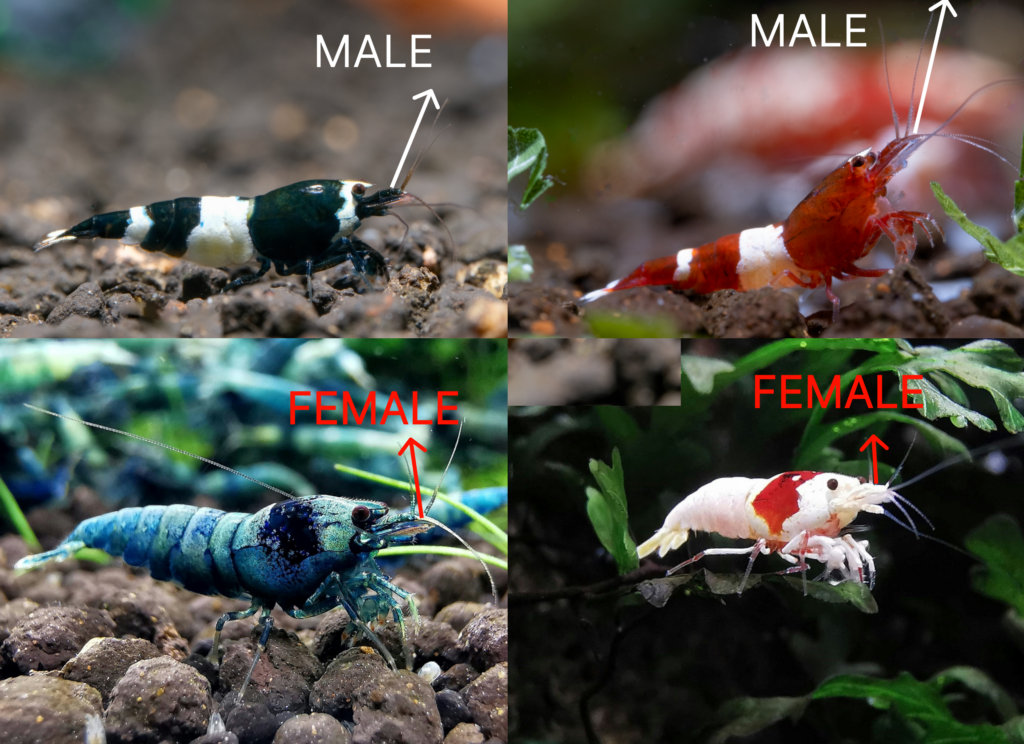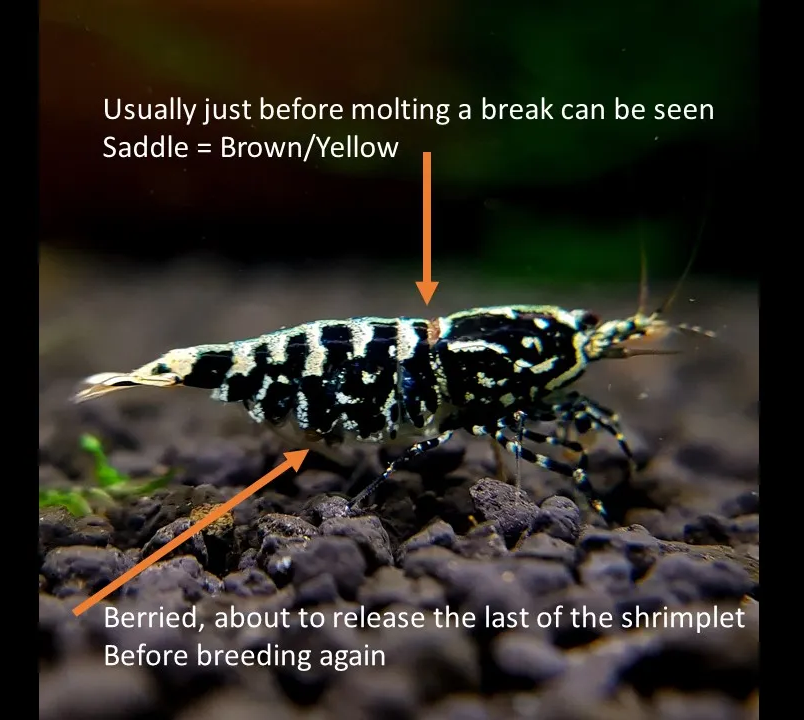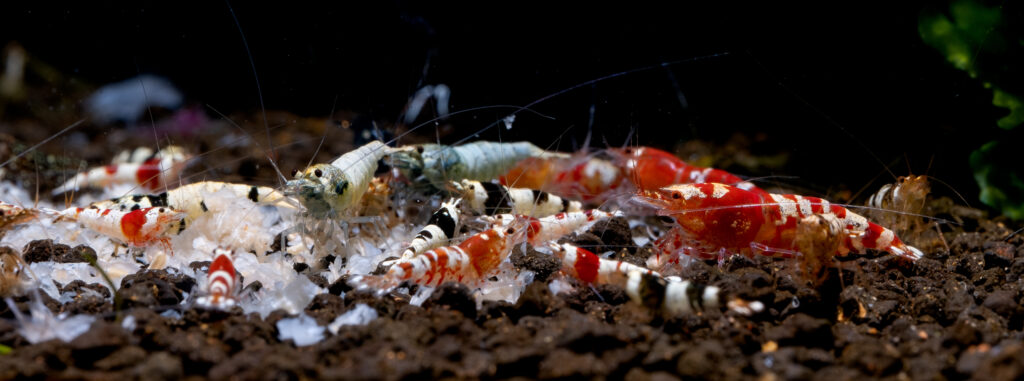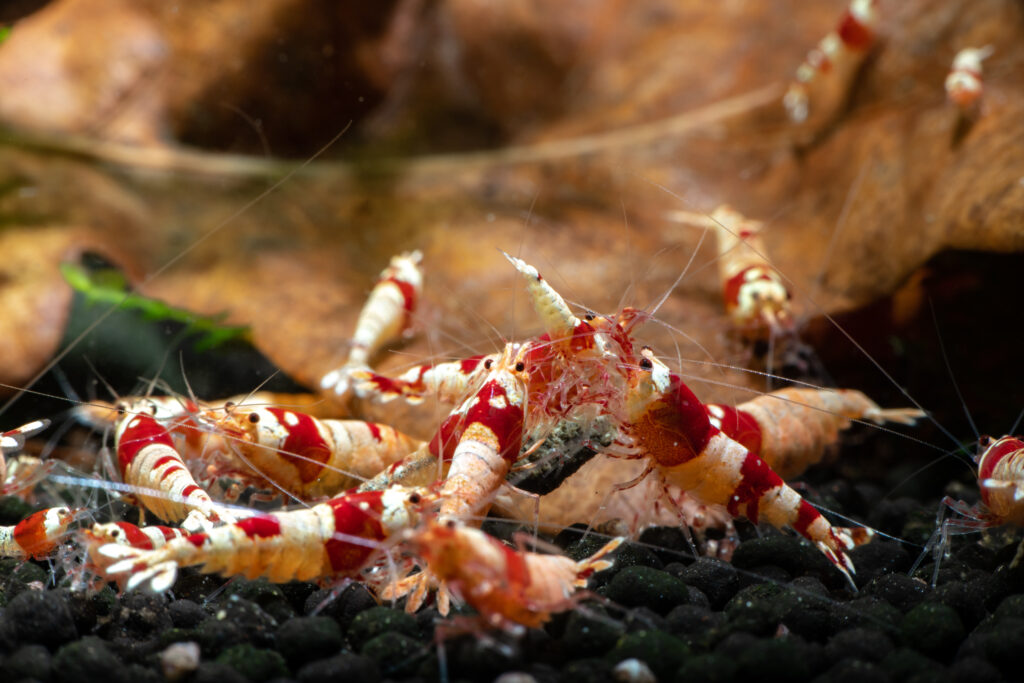Importance of Differentiating Male and Female Shrimp
Understanding the distinctions between male and female Caridina dwarf shrimp is crucial for several reasons. Firstly, it allows hobbyists and breeders to maintain balanced populations within aquariums, ensuring optimal conditions for the health and well-being of the shrimp community.
Moreover, discerning between the sexes is pivotal for those interested in selective breeding. Selective breeding aims to enhance specific traits, such as coloration, pattern, or size, in offspring. Knowledge of the sex of individual shrimp enables breeders to selectively pair males and females possessing desired characteristics, thereby increasing the likelihood of producing offspring that exhibit those traits.

By grasping the nuances of sexing Caridina dwarf shrimp, aquarists can embark on more informed breeding projects and contribute to the enhancement of these captivating crustaceans within the aquarium hobby.
The Taiwan Way of Differentiating
Separating Shrimplets at an Early Stage
Distinguishing between male and female shrimp becomes more evident as they reach a size of 0.8cm. At this stage, some males already begin to mate. So, it is crucial to separate the shrimplets to prevent any inadvertent mating between shrimplets and their parents. This can be done by relocating all shrimplets to a grow out tank. As the shrimplets mature, they will once again be sorted by gender to ensure proper breeding management.
Methods of Differentiating
- Antennae Length: One of the primary methods used in Taiwan for sexing Caridina dwarf shrimp is by examining the length of their antennae.
- Saddle: Another distinguishing feature is the presence or absence of a saddle, which is a small saddle-shaped marking located on the back of female shrimp.
- Rounded Abdomen (Females): Female shrimp tend to have a more rounded abdomen, particularly evident when they are carrying eggs.
Antennae Length
- Most Accurate Method After 0.8 cm Size
To identify the gender of Caridina shrimp, observing their antennae can serve as a dependable method. Shrimp possess three pairs of antennae – top, bottom, and side. However, it’s the top pair of antennae that provides the most insight into distinguishing between males and females. Typically, females have shorter top antennae compared to males, whose antennae are notably longer. Males often exhibit top antennae that are approximately 1.5 times longer than those of females. It’s essential to examine multiple shrimp within a colony to accurately determine their gender based on antennae length. While antennae sexing is generally more reliable than other methods such as examining the abdomen, it can be challenging to discern differences in shrimp smaller than 2 cm. Despite its limitations, antennae sexing remains a fairly accurate and valuable tool for identifying the gender of Caridina shrimp.

Saddle and Rounded Abdomen
Visible in Larger, Breeding-Size Females
As Caridina dwarf shrimp mature, particularly females, two prominent features become more apparent: the saddle and the rounded abdomen. The saddle, a small saddle-shaped marking located on the back of the female shrimp, becomes increasingly visible in larger, breeding-size females. This marking is an indication of the shrimp being ready to produce eggs.

Caution: Too Late for Selective Breeding at This Stage
However, it’s important to exercise caution when relying solely on the presence of the saddle for selective breeding purposes. By the time the saddle becomes clearly visible, it may be too late to initiate selective breeding efforts for specific traits. So it’s best to first separate the shrimplets by moving them to a grow out tank to prevent unintentional breeding.
Importance of Early Separation to Avoid Unintended Breeding
Early separation of shrimp based on sex not only facilitates accurate sex identification but also helps prevent unintended breeding within the tank. Uncontrolled breeding can lead to overcrowding and genetic dilution of desirable traits, undermining the objectives of selective breeding initiatives. Proactive measures such as early sex differentiation and separation are crucial for maintaining breeding programs’ integrity and achieving desired outcomes.

Other Factors and Considerations
Curve of the Second Carapace is Not a Reliable Indicator
While various methods exist for sexing Caridina dwarf shrimp, some factors may not reliably indicate gender. For instance, the curve of the second carapace, often cited as a potential indicator, may not consistently differentiate between males and females across all shrimp populations.
Size Alone is Not a Reliable Indicator
Similarly, relying solely on size as a determinant of sex can be misleading. Shrimp of the same species and age may exhibit significant size variations influenced by factors such as genetics, diet, and environmental conditions.
Difficulty in Judging Size from Pictures
Judging shrimp size accurately from pictures can be challenging due to factors such as perspective distortion and image resolution. Therefore, it’s advisable to supplement visual assessments with other sexing methods for greater accuracy.
Importance of Practice and Experience
Mastering the art of sexing shrimp using these methods requires practice and experience. Seasoned breeders emphasize the importance of honing observational skills over time, as subtle differences can be challenging to discern, especially in juvenile shrimp.
After Differentiating Males and Females
Splitting Males and Females into Separate Tanks
Once males and females have been accurately differentiated, it’s imperative to separate them into individual tanks to prevent unintended breeding and facilitate controlled selective breeding efforts. Keeping males and females apart ensures that breeding occurs only when desired, allowing breeders to maintain control over their breeding programs and outcomes.
Selective Breeding Process
Selective breeding involves deliberately pairing specific males and females that possess desired traits to produce offspring with those same desirable characteristics. This process requires careful planning, observation, and record-keeping to track lineage and trait inheritance accurately. By selectively breeding shrimp, hobbyists can enhance desirable traits over successive generations, contributing to the ongoing improvement and diversity of the Caridina dwarf shrimp population.

Importance of Proper Tank Setup and Cycling
In addition to separating males and females, ensuring proper tank setup and cycling is essential for successful breeding endeavors. A well-established and appropriately cycled aquarium provides a stable environment conducive to shrimp health and reproduction. Factors such as water parameters, substrate, filtration, and plant life play crucial roles in creating an ideal habitat for breeding shrimp.










